 |
Theater

The history of Hungarian theatre goes back more than two hundred years.
It was not until 1789 that a Hungarian company was officially given its own theatre.
Having a permanent building for a Hungarian Theatre, became a cause for celebration to the bourgeoisie.
Naturally, the existence of the new theatre exerted a profound influence on national playwriting, as well as for the intermittent dramatic efforts.
By the mid-1800s, a generation of playwrights had emerged with the capability of satisfying the appetites of several Hungarian-language repertory theatres.
Almost every major poet tried their hand in drama writings.
Sándor Petõfi (The Tiger and the Hyena (Tigris és hiéna, 1845) and Mihály Vörösmarty (Treasure Hunters [Kincskeresõk], circa 1839 and Blood-Marriage (Vérnász, 1833) were perhaps the most famous theatre works.
This period also saw the first important translations of Shakespeare.
First and foremost by the great nineteenth-century poet János Arany, who translated, among others, A Midsummer Night’s Dream and Hamlet.
These translations not only made Shakespeare available to the Hungarian audience, but also exerted an influence on the new generation of dramatists.
In the second half of the 19th century, small towns in Hungary began building theatres.
Ninety percent of Hungarian theatres in existence today were built in the 19th century.
Their designers were the two illustrious architects Ferdinand Fellner and Hermann Helmer.
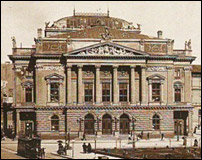
Three theatres were fully supported by the Hungarian government— the Opera House, the National Theatre in Budapest and the National Theatre of Szeged.
With a progressive theatre program, private theatres also began to thrive, among these the Vígszínház.
In Budapest alone, there were more than twenty theatres, not to mention the literary cafés and Cabarets.
By the turn of the century this theatrical structure remained in operation until the Communist takeover in 1949.
In 1949, Hungarian theatres were nationalized.
The theatre became the main forum for the fight against political oppression — a position that went unrivalled until the free elections of 1989.
It should be stressed that until the 1980s, the National Theatre was the country’s most progressive theatrical workshop— the major venue for the clash of viewpoints on cultural policy.
Although the cultural policy of the communist era tied the hands of the artists, the funding of the theatre programs from the state allowed quality programs.
Salaries, in comparison to an average worker’s wage were high, and the more talented actors and directors were given many other opportunities apart from work in the theatre.
They worked in radio, television, the dubbing studios and film, which at the time, were enjoying worldwide.
In effect, until the 1990s, a significant percentage of actors enjoyed a high standard of living.
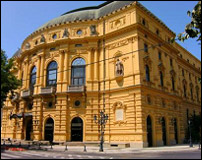
The greatest theatre change since 1989, has been brought about by the appearance of dance theatres.
One of the tangible reasons for their establishment has been the nonlinguistic nature of dance; the fact that dances companies can appear outside the country without having to overcome linguistic Barriers.
Of these companies, Yvette Bozsik’s dance theatre is perhaps the most interesting and has been well known in countries around the world.
Az estély (The Ball) won a special prize at the Edinburgh Festival.
At present, the Hungarian theatrical structure is based on thirty-five theatres that have their own permanent companies.
Together, these theatres hold approximately 300 premieres per year, with nearly 12,000 performances.
These theatres are still being financed either by the government or other budgetary institutions of the state.
Including the outdoor theatres, there are altogether forty-six theatrical institutions currently functioning in Hungary.
Aside from the thirty-five theatres that have their own companies (seven being puppet theatres), there are five institutions that function as venues and six independent outdoor theatres.
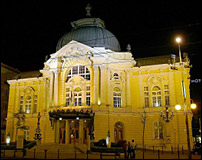
There are many famous Hungarian theater and movie actors over the last 150 years.
Two Hungarians were influential in the development of the Hollywood film industry: Adolph Zukor (1873-1976), the founder of Paramount Pictures; and William Fox (1879-1952), the founder of Twentieth Century-Fox.
Zukor and Fox transformed the stylish Biedermeier culture of the Austro-Hungarian Empire into the glamorous society portrayed in Hollywood film.
Other pioneers in the film industry included directors/producers Michael Curtiz (born Kertész; 1888-1962), Sir Alexander Korda (1893-1956), George Cukor (1899-1983), and Joseph Pasternak (1901–1991)
 |
Béla Lugosi
Béla Ferenc Dezsõ Blaskó (20 October 1882 – 16 August 1956), commonly known as Béla Lugosi, was a Hungarian actor of stage and screen.
He was best known for having played Count Dracula in the Broadway play and subsequent film version, as well as having starred in several of Ed Wood's low budget films in the last years of his career.
Lugosi, the youngest of four children, was born as Béla Ferenc Dezsõ Blaskó in Lugos (at the time part of Austria–Hungary, now Lugoj in Romania), to Paula de Vojnich and István Blaskó, a Banker.
He later based his last name on his hometown.
|
 |
 |
Johnny Weissmuller
Johnny Weissmuller (June 2, 1904 – January 20, 1984) was a Hungarian born American swimmer and actor, best known for playing Tarzan in movies.
Weissmuller was one of the world's best swimmers in the 1920s, winning five Olympic gold medals and one bronze medal and set sixty-seven world records.
After his swimming career, he became the sixth actor to portray Edgar Rice Burroughs's ape man Tarzan in films, a role he played in twelve motion pictures.
|
 |
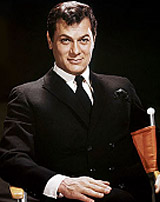 |
Tony Curtis
Tony Curtis (born Bernard Schwartz; June 3, 1925 – September 29, 2010) was, one of three sons of Emanuel Schwartz and Helen Klein.
His parents were Hungarian Jewish immigrants from Mátészalka, Hungary.
Hungarian was Curtis' only language until he was five or six, postponing his schooling.
His career spanned six decades, but had his greatest popularity during the 1950s and early 1960s.
He acted in over 100 films in roles covering a wide range of genres, from light comedy to serious drama.
In his later years, Curtis made numerous television appearances.
|
 |
 |
Elizabeth Kaitan
Elizabeth Kaitan (born July 19, 1960) is a Hungarian-American actress and model.
Elizabeth Kaitan was a model for the Bonnie Kay Agency in New York City in the early 1980s.
Kaitan is perhaps best known for her roles in movies such as Savage Dawn (1985), Silent Night, Deadly Night Part 2 (1987) as Jennifer, Friday the 13th Part VII: The New Blood (1988) as Robin, and in Vice Academy Parts 3, 4, 5, & 6" as Candy.
|
 |
 |
Eva Gabor
Eva Gabor (February 11, 1919 – July 4, 1995) was a Hungarian-born socialite and actress.
She was widely known for her role on Green Acres as Lisa Douglas, the wife of Eddie Albert's character, Oliver Wendell Douglas, Duchess in the 1970 Disney film The Aristocats, and Miss Bianca in Disney's The Rescuers and The Rescuers Down Under.
Gabor had success as an actress in film, Broadway and television.
Her elder sisters, Zsa Zsa Gabor and the late Magda Gabor, were also actresses and socialites.
Born in Budapest, the last daughter of Vilmos Gábor (1884–1962), a soldier, and Jolie Gábor (died 1997), Eva was the first Gabor sister to immigrate to the United States.
|
 |
 |
Zsa Zsa Gábor
Zsa Zsa Gabor (born February 6, 1917) is a Hungarian-born American stage, film and television actress.
She acted on stage in Vienna, Austria, in 1932, and was crowned Miss Hungary in 1936.
She immigrated to the United States in 1941 and became a sought-after actress with "European flair and style", with a personality that "exuded charm and grace".
Her first movie role was as supporting actress in Lovely to Look At.
She later acted in We're Not Married! And played one of her few leading roles in Moulin Rouge (1952), directed by John Huston, who described her as a "creditable" actress.
Besides her film and television appearances, she is best known for having nine husbands, including hotel magnate Conrad Hilton and actor.
|
 |
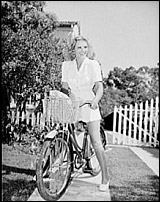 |
Ilona Massey
Ilona Massey (born Ilona Hajmássy; June 16, 1910 – August 20, 1974) was a film, stage and radio performer.
She was born in Budapest, Austro-Hungarian Empire (now Hungary).
Billed as "the new Dietrich", she starred in three films with Nelson Eddy, including Rosalie (1937), and with Lon Chaney, Jr. in Frankenstein Meets the Wolf Man (1943) as Baroness Frankenstein.
In 1943, she appeared in the Ziegfeld Follies.
In 1947, she starred with Eddy in Northwest Outpost, a musical film composed by Rudolf Friml.
In 1949, she starred in Love Happy with the Marx Brothers.
She played Madame Egelichi, a femme fatale spy, and her performance inspired Milton Caniff in the creation of his femme fatale spy, Madame Lynx, in the comic strip "Steve Canyon".
|
 |
 |
Lucy Doraine
Lucy Doraine (22 May 1898 – 14 October 1989) was a Hungarian film actress of the silent era.
Born as Ilona Kovács in Budapest, she appeared in 24 films between 1918 and 1931.
She was married to movie director Michael Curtiz from 1918 to 1923.
She died in Los Angeles, California, at age 91.
|
 |
|
 |